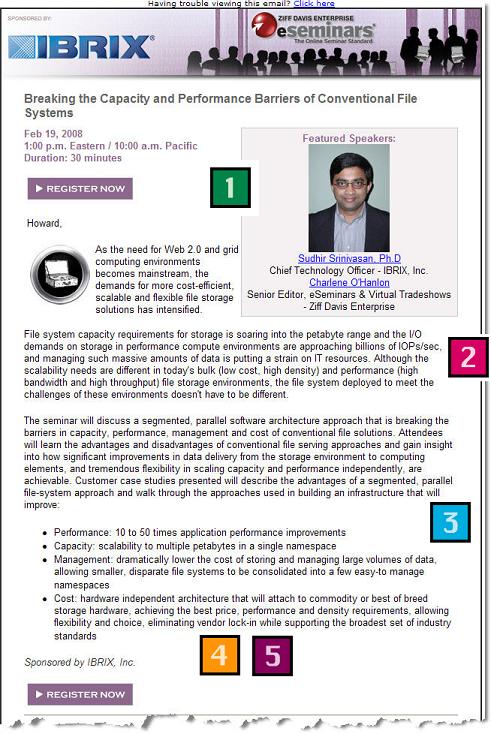This Webinar invitation from IBrix, a developer of software-based file-serving solutions, arrived in my inbox recently. Alas, it reads more like an abstract for a thesis presentation than a compelling sales event. Here are the all-too-common pitfalls the invitation so painfully illustrates:
1. Don’t place speaker photos and gratuitous clip-art in too prominent a position, such that they force more vital selling copy below the fold.
2. Don’t waste the critical first two paragraphs of your invitation telling the reader about the state of the universe; instead grab the reader early by describing what he or she will learn by attending the Webinar.
3. Don’t call them “customer case studies.” That’s marketing-speak. Call them “compelling real-life accounts demonstrating how [insert benefit here].”
4. Don’t list “Performance”, “Capacity”, “Management”, etc. as features and expect the reader to grasp immediate value. State all features not only as benefits, but learning benefits associated with the event itself, for example: “In just 45 minutes, learn how to increase application performance by up to 5,000 percent …”
5. Provide some detail as to how the event will be organized. You don’t need to include an agenda necessarily, but the reader should at least be able to glean a rough idea of how his or her 45 minutes will play out. Without that detail, most readers will assume they’re signing up for a sales pitch.
For more ideas on how to improve Webinar response, see our new white paper: “Top 10 Tips for Webinar Invitation Success.“


Yikes.
Howard,
Thanks for the great critique. All too often, Webinar invitations are written by engineers rather than marketers. And even when Webinar invitations are written by marketers, these marketers often don’t know the first thing about crafting a compelling, benefits-rich Title, Headline or bullet points.
I was doing some research a few days ago on Herman Hollerith, the inventor of the punch card tabulating machine. Eventually despite great technical success with the 1890 U.S. Census, Hollerith’s company faltered and was acquired by a conglomerate that was eventually renamed IBM.
Hollerith, the consummate techie, often had extreme disagreements with the great granddaddy of IBM’s sales force, Thomas J Watson, Sr.
In the case of Webinars where both engineers and product marketers are involved, it’s really crucial to make sure that marketing gets the ability to say what’s needed to fill up the seats. Or the engineer will unfortunately be speaking to an empty virtual meeting room.
Joshua,
In defense of Ibrix, I now suspect that most of the blame for this invitation falls upon Ziff-Davis, the publisher hosting the event. I’ve received a couple of other invitations from them since and they all follow the same basic format.
Still, if anything, it makes it all the more inexcusable since – to your very point – at least if Ibrix had designed the invitation you could excuse them for being engineers, whereas Ziff-Davis should know better. One wonders just how much better their Webinar programs would perform across the board if they’d simply follow a few basic direct marketing principles.
Howard
Good points.
I’ve seen your other posts with email critiques, but can’t recall seeing an example of a “great” email. Can you share one of your more stellar examples? Thanks!
Jason – will do, though it must be said I see far more bad e-mails than good. In the meantime, see this earlier post for a story about a Webinar invitation we designed for a software client.
Howard
I would like to see a ” Steller” example of a Webinar invitation as well.
Robin
Jason, Robin – in addition to the post referenced two comments above, see also this earlier post comparing Webinar invitations from Oracle and Netsuite.
Howard